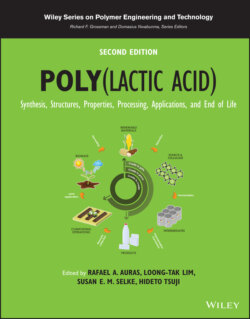Читать книгу Poly(lactic acid) - Группа авторов - Страница 108
5.1 INTRODUCTION
ОглавлениеAn intermolecular complex formed by macromolecules having identical chemical composition but different configuration of the repeating units is known as a stereocomplex (sc) [1]. The co‐crystallization of the stereoisomers PLLA and PDLA results in the formation of a well‐known crystal structure stereocomplex PLA (sc‐PLA). The sc‐PLA gained widespread recognition and acceptance ever since it was discovered by Ikada et al. [2] and patented by Murdoch and Loomis [3]. Stereocomplexation in PLA is attributed to the non‐covalent interaction of the enantiomeric macromolecular chains. The sc‐PLA crystals melt at a temperature (T m) 50°C higher than the homochiral (hc) PLLA or PDLA crystals [4]. Apart from the improved heat resistance, sc‐PLA has better mechanical performance and resistance to hydrolysis [5, 6] than PLLA and PDLA, allowing its exploration in pharmaceutical and biomedical applications. The homopolymers PLLA or PDLA have been utilized for short life applications such as agricultural mulch‐films, disposable trays and bottles, and nonwovens. On the other hand, sc‐PLA can be specifically adopted for high‐performance applications such as structural and engineering plastics [7]. Several studies have also made use of sc‐PLA for drug delivery application due to its improved barrier properties, which prevent the burst release and prolong the release of drugs [8]. The formation of sc crystals may therefore lead to the development of PLA‐based materials with enhanced performance. The molecular weight, optical purity of the enantiomeric PLA, and tacticity are the governing parameters for the sc crystallization; lower optical purity or higher molecular weight likely hinders the sc crystallization [9, 10]. The formation of hc crystals is often more kinetically favorable than that of sc crystals during the crystallization of high‐molecular‐weight PLLA/PDLA blends. However, enhancing the interchain interactions between PLLA and PDLA by covalent or non‐covalent means can improve the formation of sc crystallites [11]. Also, sc crystallizes much faster from the melt as compared with the α‐form. Researchers have been studying the varied crystal morphologies of sc‐PLA and the governing parameters for their formation. A preferential formation of sc can be attained by blending PLLA/PDLA in equimolar (1 : 1) ratio in solution. However, varying the ratios of PLLA/PDLA in the blend give rise to the formation of hc‐PLA (T m ~ 180°C) along with sc‐PLA (T m ~ 230°C). In order to improve the sc formation in non‐equimolar blends of PLLA/PDLA, several methodologies have been adopted, some of which are highlighted in this chapter.
